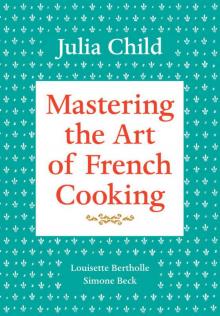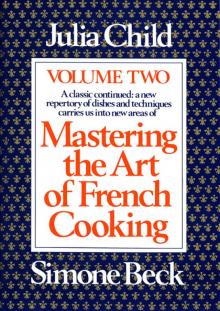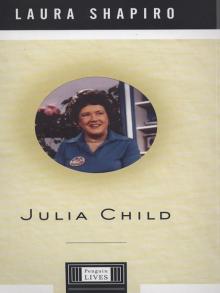- Home
- Julia Child
My Life in France Page 21
My Life in France Read online
Page 21
Unfortunately, this was not a message that the food editors of America wanted to hear or had the technical knowledge to appreciate.
Most of our pupils had traveled and cooked for years, but did not know how to sauté, or cut a vegetable quickly, and had no conception of how to treat an egg yolk properly. I knew—because they told me so—that they wanted this information and were willing to work for it. So I was convinced there would be a market for our work. Would Houghton Mifflin agree?
In the days leading up to our meeting, I rehearsed the arguments I would make in Boston in my correspondence with John Leggett, the publisher’s New York editor. He was concerned about the scope and detail of French Cooking for the American Kitchen. “Good French food cannot be produced by a zombie cook,” I wrote him. To get the proper results, one had to be willing to sweat over it; the preliminaries must be performed correctly and every detail must be observed. “Ours is the only book either in English or in French which gives such complete instructions,” I explained. It “constitutes a modern primer of classical French cooking—an up-to-date Escoffier, if you will, for the American amateur of the ‘be your own French chef’ persuasion.”
On February 23, the day before our appointment at Houghton Mifflin, it was snowing so hard that all of the trains to Boston were canceled. Simca and I looked at each other. After we had put so many years of hard work into French Cooking for the American Kitchen, would a mere blizzard stop us? Non! We were determined to deliver what we’d promised.
Late that morning, we boarded a bus. It chugged and slithered northward through the driving snow for hour upon hour, while one or the other of us clutched a cardboard box holding our precious manuscript in our laps. At about 1:00 a.m., we finally straggled into Avis De Voto’s house, on Berkeley Street, in Cambridge.
The next day, it was still snowing. Simca and I made our way to 2 Park Street, in Boston, where we mounted a long flight of stairs. Cradling our precious box under my arm, I had no idea how our efforts would be received. In the editorial offices, we finally met Dorothy de Santillana, a nice, straightforward woman who understood cooking and seemed genuinely enthusiastic about French Cooking for the American Kitchen. But we did not get a very warm feeling from her male colleagues. One of them muttered something like “Americans don’t want an encyclopedia, they want to cook something quick, with a mix.”
Simca and I left our seven hundred authoritative pages on soups and poultry with them, slowly descended the long flight of stairs, and returned to Avis’s through the snow. Neither of us said much.
A few weeks later, we received a letter from Dorothy de Santillana:
Our most careful group eye has been brought to bear on the fruit of what is self-evidently the most careful labor of love . . . and the problem presented is complex. . . . With the greatest respect for what you have done . . . we must state forthwith that this is not the book we contracted for, which was to be a single volume book which would tell the American housewife how to cook in French.
From here we must talk publishing, not cooking. . . . What we could envisage as saleable . . . is perhaps a series of small books devoted to particular portions of the meal. Such a series would have a logical sequence of presentation . . . such as soups, sauces, eggs, entrees, etc. . . . Such a series should meet a rigorous standard of simplicity and compactness, certainly less elaborate than your present volumes, which, although we are sure they are foolproof, are undeniably demanding in the time and focus of the cook, who is so apt to be mother, nurse, chauffeur, and cleaner as well.
I know this reaction will be a disappointment to you, but I wonder if this isn’t the time for you to do some re-thinking yourself on the project which has . . . grown into something much more complex and difficult to handle than the original book.
Ah me, our poor Gargantua. What would become of it?
It was true that we had not delivered the book Houghton Mifflin had contracted for. It was also true that the trend in the U.S.A. was toward speed and the elimination of work, neither of which we had furthered in our seven-hundred-page treatise. And it was true that the publisher’s suggestion of a simplified series of booklets aimed at the housewife/chauffeur would appeal to a wide audience. Yet the book Houghton Mifflin envisioned was not the book Simca and I were interested in. We felt that the mass audience was already abundantly served by women’s magazines and most cookbooks. We were far more interested in readers who were devoted to serious, creative cookery. We knew this was an audience that needed and wanted attention. It would, however, be a relatively small audience. Furthermore, the publishing business was in a period of doldrums.
What to do?
Simca and I agreed that, though we would be willing to prune our manuscript a reasonable amount, our objective remained firm: to present the fundamentals of classical French cooking in sufficient detail that any loving amateur could produce a perfect French meal. Houghton Mifflin was clearly not interested in this. And it was possible—maybe likely—that no other publisher would take a flyer on this kind of book, either. But before relinquishing our dream, we wanted to peddle the idea around.
With Simca standing over my shoulder, I typed a letter to Mrs. de Santillana, suggesting we return Houghton Mifflin’s $250, the first third of the advance, and cancel our contract for French Cooking for the American Kitchen. “It is too bad that our association must come officially to a close,” I wrote. “But we still have a good 30 or 40 more years of cook bookery in us, so we may sometime be able to get together again.”
Ouf! I went to bed that night feeling empty.
The next day, I crumpled the letter up. Inserting a fresh page into the typewriter, I wrote in a new vein: “We have decided to shelve our own dream for the time being and propose to prepare you a short and snappy book directed to the somewhat sophisticated housewife/chauffeur.”
It had been an extremely difficult decision. But Simca and I had finally conceded that it made more sense to compress our “encyclopedia” into a single volume, about 350 pages long, of authentic French recipes—from hors d’oeuvres to desserts—than to hunt for a new publisher right now. “Everything would be of the simpler sort, but nothing humdrum,” I wrote. “The recipes would look short, and emphasis would always be on how to prepare ahead, and how to reheat. We might even manage to insert a note of gaiety and a certain quiet chic, which would be a pleasant change.” As we had already tested our recipes, I promised to have the new manuscript finished within six months, or less.
Mrs. de Santillana wrote back, approving our new plan.
We knew we’d have to emphasize the simpler cuisine bourgeoise dishes over the grande cuisine. After all, our readers wouldn’t have mortars and pestles for pounding lobster shells, or copper bowls for whipping egg whites, and they weren’t used to taking the time and care over sauces that the French were accustomed to. Perhaps that would come with time. For now, I could see clearly that our challenge was to bridge the cultural divide between France and America. The best way to do that would be to emphasize the basic rules of cooking, and impart the things I’d learned from Bugnard and the other teacher-chefs—not least of which was the importance of including fun and love in the preparation of a meal!
III. OSLONIANS
PAUL HAD DECIDED to retire from government service when he turned sixty, in 1962, in order to devote himself to painting and photography. The next question was: what—and where—would we retire to? We didn’t love Washington enough to want to stay there, and we felt that California was too far away from our closest family and friends. We debated the subject back and forth, and after several visits to Avis De Voto in Cambridge, Massachusetts, we said to each other: “Now, there’s a place we can agree on.”
Paul had grown up in and around Boston and taught at the Shady Hill School in the 1930s, and felt comfortable there. I found Cambridge to have a special, charming New England character and to be full of interesting eggheads. Over the Fourth of July weekend, 1958, a real-estate agent friend of Avis’s wa
lked us about the narrow, winding streets behind the Harvard and Radcliffe campuses. We didn’t see anything that appealed, but as we left, Avis said she’d keep an eye out for us.
Back in Washington, Paul had been given the title “acting chief of the exhibits division,” which meant he was the USIA’s top exhibits man. It was a temporary post that he held for about six months in 1958. In the meantime, we began to study Norwegian in preparation for our next posting. We were being sent to Oslo, where Paul would become the U.S. cultural attaché, starting in 1959.
While in Washington, I had met John Valentine Schaffner, a New York literary agent who represented James Beard and Mrs. Brown of “the Browns,” among others. I asked him about how Simca and I should make ourselves known to our vast potential public. He implied that the professional cooking world (both in the U.S. and in France) was a closed syndicate that was difficult to penetrate. So it may have been, but it was our intention to break into this group on a permanent basis. Clearly, we’d be in a better position to do so once we had a finished cookbook in hand. Simca and I bore down, working our stoves and typewriters to a white-hot heat.
In January 1959, as we were preparing to shove off for Norway, Avis called to say that a “special” house in Cambridge was coming on the market, and that we should drop everything and come right away to see it. It was a day of freezing rain, but we jumped on the train to Boston and had a look at the big, gray-shingled house she had described. It had been built in 1889 by the philosopher Josiah Royce (a native Californian, like me), and stood at 103 Irving Street, a small leafy byway tucked behind Harvard Yard. The house was three stories tall, with a long kitchen and a double pantry, a full basement, and a garden. We walked through it for about twenty minutes, and as Paul tapped the walls and floors to judge their soundness, I stood in the kitchen and imagined myself living there. Another family was touring the house at the same time. While they talked it over in low voices, we decided that we’d never find anything better and bought it on the spot. We paid something like forty-eight thousand dollars for it. It needed updating and improving, but we’d be able to pay for that by renting it out while we were in Norway. Hooray!
AS OUR FERRYBOAT from Denmark made its way up the winding Oslo Fjord in May 1959, we looked at the granite boulders and high cliffs covered with pine trees, sniffed the cool, salty-piney air, and said to each other: “Norway is just like Maine!” Which it was, and wasn’t.
You can prepare yourself to enter a new culture, but the reality always takes some getting used to. At that latitude, at that time of year, the surprisingly bright sun didn’t set until 10:20 p.m. and rose again almost immediately, at 4:00 a.m., which made sleep difficult. Furthermore, Norwegian beds are covered by a single down coverlet, which is as hot as a baker’s oven but only big enough to cover half of one’s body. We licked that problem by pulling it up to our chins and piling our car blanket and various bits of clothing onto our legs and feet.
There were hardly any pussycats about, I noticed, but plenty of dogs, and more redheads per square meter than anywhere else I’d ever been. Every Norwegian seemed to be good-looking and healthy, and to have an air of uncomplicated niceness.
The entire USIA staff in Oslo consisted of only three Americans and one Norwegian secretary. When a big shot like Buckminster Fuller came to town, Paul would have to put aside his usual pile of work to arrange lectures and press coverage and chauffeur the great man around. In the meantime, the U.S. Embassy was moving into a handsome new building designed by Eero Saarinen.
By June, we’d found a lovely house to rent in the suburbs, a two-story white clapboard, rather New Englandy–looking place, complete with a preposterous electric stove, an untuned piano, and ants. I hated ants, and set out to poison the little buggers. There were green hedges and fruit trees and climbing roses. The raspberries were ripening fast, and we had both the large strawberries and the little fraises des bois, which were highly perfumed and really good (better than the ones we’d had in France, which tasted woody).
I unpacked my vast batterie de cuisine—seventy-four items in total, from cheese graters to copper pots—arranged the kitchen to my liking, and began to take language classes. Soon my Norsk was good enough so that I could read the newspaper and go shopping. The fish and bread were excellent, as were the strawberries, raspberries, and gooseberries, but we were less impressed with the local meat—which included haunches of moose and reindeer—and the rather wan vegetables.
My favorite place to shop was a fish store with a stupendous window display: three-foot-long salmon crossed over each other, surrounded by salmon trout and interspersed with lobster, mackerel, flounder, and halibut. Above this was a garland of little pink shrimp. I would get to know this shop well, with its jolly fishermen standing around boxes of big crabs, great half-carved sturgeon, and live cod swimming in long tanks made of cement. One afternoon I stopped by when an Englishwoman was trying to take a definitive photograph of a cod. A fisherman obligingly pulled a giant specimen out of the tank, held it in his arms, scratched its belly, and cooed to it; the fish squeakily cooed back to him. What a fine act!
Aside from my French-cooking research for the book, I began to experiment with local produce. I picked red currants and made batches of jelly, tried gravlax for the first time (delicious served with a dill-cream sauce, and Steurder potatoes with cream and mace), and cooked a ptarmigan and a large European grouse called a capercailzie.
As I knew hardly a soul in Oslo, I got a great deal of work done on The Book that summer. Letters between Oslo and Paris flew back and forth at a great rate. After nearly eight years of hard labor, Simca and I could see the end in sight, and spurred each other on to heroic feats of typing.
IV. A GODSEND IN DISGUISE
SEPTEMBER 1, 1959, marked our thirteenth wedding anniversary, and I had just turned forty-seven years old. But the really exciting news was that the revised French Recipes for American Cooks was finished at last—ta-da!
I sent the manuscripple off to a friend in Washington for an immaculate typing up, and from there it would go to Houghton Mifflin in Boston. The book was now a wholly different beast from our original “encyclopedia” on soups and poultry. It was a primer on cuisine bourgeoise for serious American cooks, covering everything from crudités to desserts. But it was still 750 pages long, and I worried how the editors would react. We wouldn’t hear their comments for another month, and there was nothing we could do but cross our fingers and hope for the best.
What a strange feeling to be done with The Book. It had weighed so like a stone these many years, you’d think I’d be tripping about in ecstatic jubilation. But I felt rootless. Empty. Lost. I sunk into a slough of discombobulation.
Oh, how I yearned for a passel of blood-brother friends to celebrate with. We had plenty of acquaintances in Oslo, but, as in Plittersdorf, we suffered months and months of nobody to really hug but ourselves. This was the thing I hated most about the itinerant diplomatic life.
When I finally got myself invited to a large ladies’ lunch, we were served canned shredded chicken in a droopy, soupy sauce, and brownies from a mix. Yuck.
My mood buoyed when I received an enthusiastic note from Dorothy de Santillana at the end of September.
I have spent four full days studying the manuscript . . . which is a very long time for any single editorial reading. . . . I was intensely occupied every minute and remain truly bowled over at the intensity and detail with which you have analysed, broken down, and reconstructed every process in full minutiae. I surely do not know any compendium so amazingly, startlingly accurate or so inclusive, for it seems to me almost completely inclusive in spite of your formal announcement that [pâte feuilletée] won’t be found!
This is work of the greatest integrity and I know how much of your actual life has gone into it. It should be easily recognizeable to anyone.
. . . I would like to add that I got out Knopf’s most recent entry . . . Classic French Cuisine by Joseph Donon, and that compared to
you Chef Donon not only doesn’t deserve the word classic, he doesn’t even deserve the word French, in spite of his Legion of Honour!
. . . There is nothing for me to do now except wait for the executives to do their figuring.
I replied immediately, to tell her how delighted we were to be one step closer to publication and to set the record straight about my co-authors. Louisette, I explained, had suffered “family difficulties” (her husband was an ogre, it turned out, and they were getting divorced), and she had not participated much in the writing process. But Simca and I agreed on the importance of keeping Louisette “on the team,” both in deference to the work she’d done, and because of the more practical matter that she was much better socially connected than either of us, both in both France and in the U.S.A.
As for Simca, I wanted to make sure that she got proper credit for her labors. The book, I wrote, “is a joint operation in the truest sense of the word as neither of us would be able to operate in this venture without the other.” Simca wrote the entire dessert chapter and included many special twists to make traditional desserts especially delicious—including her bavarois à l’orange, her mousseline au chocolat, and her magnificent charlotte Malakoff with almonds. She had supplied us with unusual sauces, including sauce spéciale à l’ail pour gigot, sauce nénette (reduction of cream, mustard, and tomato), chaud-froid, blanche neige (cold cream aspic). It was she who worked out the secret for preventing the cream from curdling in the gratin jurassien (sliced potatoes baked in heavy cream—a trade secret from the Baumanière at Les Baux), and she who devised the triumphant recipe for ratatouille, based on her many seasons in Provence.

 Julia's Kitchen Wisdom
Julia's Kitchen Wisdom My Life in France
My Life in France Mastering the Art of French Cooking, Volume 1
Mastering the Art of French Cooking, Volume 1 Mastering the Art of French Cooking, Volume 2
Mastering the Art of French Cooking, Volume 2 Laura Shapiro
Laura Shapiro